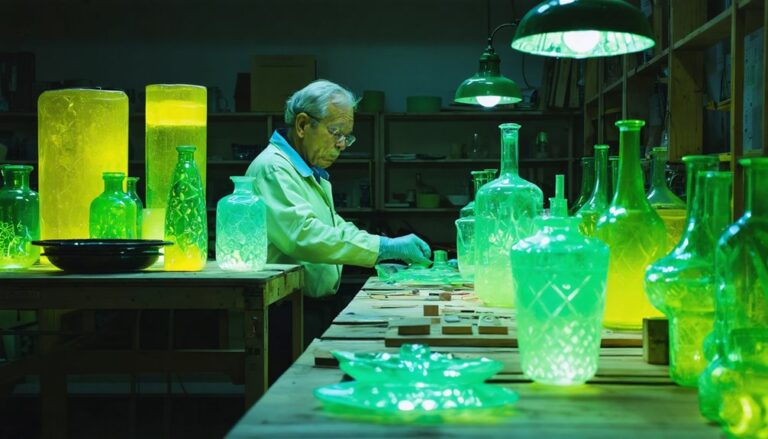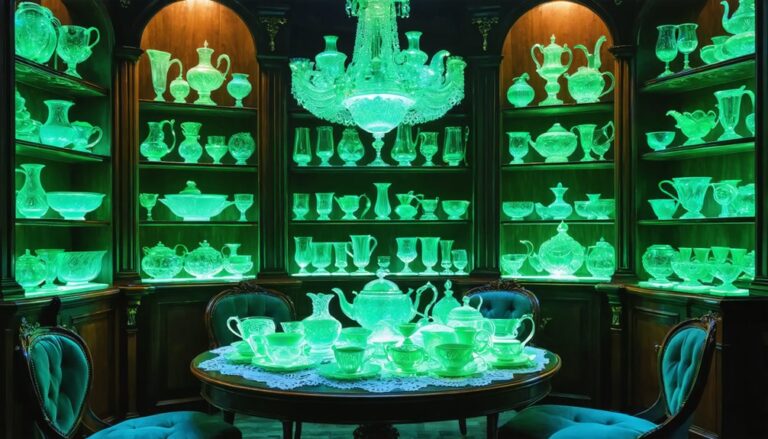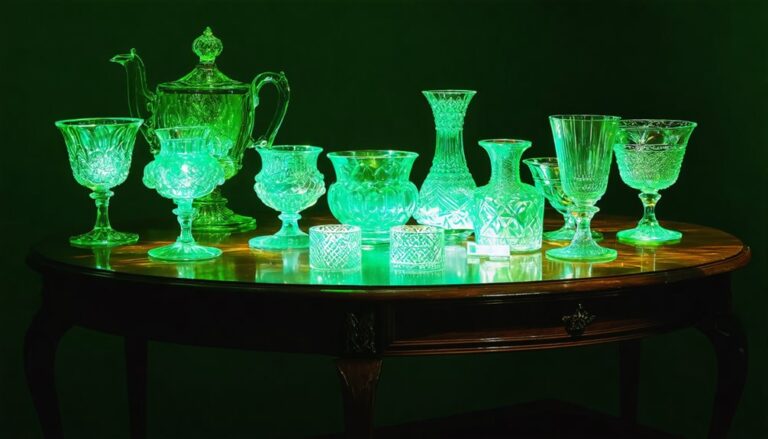Notable Early Manufacturers of Uranium Glass

Early manufacturers of uranium glass created pieces that are both historically significant and visually striking. Adams & Co produced unique designs like Wildflower, which shines brilliantly under UV light. Aetna Glass and Manufacturing Co is known for its popular Hobnail in Square pattern, prized by collectors. A.J. Beatty & Sons gained recognition for their distinctive Beatty Swirl pieces. The Boston and Sandwich Glass Company is famous for rare items like the Horn of Plenty plate.
These artisans played a crucial role in the early uses of uranium glass. The glass itself contained small amounts of uranium, which gave it a captivating glow. Initially, it was used for decorative items and tableware, appealing to those who appreciated its unique aesthetic. Collectors today still seek these pieces, highlighting their ongoing importance in the history of glass manufacturing.
Exploring these manufacturers reveals more about the artistry and innovation of the time. Each company contributed to the popularity of uranium glass, leaving a lasting legacy that continues to fascinate enthusiasts and historians alike.
Key Takeaways
Adams & Co, established in 1851, was known for its lively uranium glass. Their pieces often featured charming patterns like Wildflower, which glowed brilliantly under UV light. This vibrant glassware caught the eyes of collectors and enthusiasts alike.
Aetna Glass and Manufacturing Co, founded in 1880, contributed to the world of uranium glass with its unique Hobnail in Square pattern. This design added a touch of elegance to their historical glass items, making them popular among those who appreciated fine craftsmanship.
A.J. Beatty & Sons began operations in 1863. They created remarkable pieces, including the Beatty Swirl and Daisy and Button patterns. These designs showcased the versatility and beauty of uranium glass, attracting attention for their intricate details.
The Boston and Sandwich Glass Company holds a significant place in history. They were the first in the United States to produce uranium glass. Among their creations, the rare Horn of Plenty plate stands out as a unique piece that collectors cherish.
Challinor, Taylor & Co. also made their mark in the early days of uranium glass. They produced distinctive items, including the whimsical Bird in Nest child’s mug. This piece reflects the playful spirit of the era and showcases the innovative use of uranium in glassmaking.
These manufacturers played a key role in the development of uranium glass. Their creativity and craftsmanship left a lasting impact on glassware history. Each piece tells a story of artistry and the unique properties of uranium glass.
Adams & Co
When we look at the history of uranium glass, Adams & Co. is a key player. This company started in Pittsburgh, Pennsylvania, back in 1851. They quickly became known for their bright and colorful uranium glass novelties.
Today, collectors are eager to find pieces from Adams & Co., especially the popular Wildflower pattern. This design was first made by them and later copied in different colors because of its appeal.
Collectors today actively seek Adams & Co.’s original Wildflower pattern, widely admired and later replicated in various captivating colors due to popular demand.
Collectors treasure Adams & Co.’s unique Victorian novelties. Items like gypsy tubs with their original lids are especially rare and sought after. Other notable creations include charming turtle salt cellars, ABC/CLOCK plates, and a fascinating small patented wheelbarrow from 1882.
Each of these pieces showcases the creativity and artistry of early uranium glass makers. Owning them feels like holding a piece of history.
Uranium glass wasn’t just a novelty; it had early practical uses too. Some items were used for everyday purposes, while others served decorative functions.
The glow of uranium glass under UV light adds to its allure, making it a favorite among collectors. Adams & Co.’s contribution to this unique art form reflects a time when glassmaking was both an art and a science.
Aetna Glass and Manufacturing Co
Aetna Glass and Manufacturing Co. was an important name in the early history of uranium glass. Founded in Bellaire, Ohio, in 1880, the company operated until 1889. Even in that short time, Aetna Glass made a lasting mark on the world of uranium glass.
In 1886, they introduced the HOBNAIL IN SQUARE pattern. This design was especially popular for items like open sugar bowls and covered butter dishes. The use of uranium oxides in their glass gave the pieces a bright, glowing quality that caught people’s eyes.
Collectors today treasure these unique creations for their historical value and striking appearance.
Though Aetna Glass had a brief existence, its contributions to the field are still recognized. Enthusiasts of uranium glass appreciate the company’s role in shaping late 19th-century American glassmaking.
The legacy of Aetna Glass continues to shine brightly among collectors and historians alike.
A.J. Beatty & Sons
A.J. Beatty & Sons played a vital role in the early history of uranium glass. The company began its journey in 1863, emerging from the Steubenville Flint Glass Works. In 1888, they expanded and opened a new glassmaking facility in Tiffin, Ohio. By 1891, they became part of the U.S. Glass Company, known as Factory R and S.
Collectors of vaseline glass recognize A.J. Beatty & Sons for their unique contributions. They created striking uranium glass patterns, including the popular BEATTY SWIRL and DAISY AND BUTTON. Their items often stand out for their craftsmanship and design.
One of their notable creations is the Over All Hobs Spooner, known for its distinct footed base. This piece is especially sought after by collectors.
A.J. Beatty & Sons helped increase the appeal of uranium glass from the late 19th century into the early 20th century. Their work not only showcased innovative designs but also played a critical role in spreading the popularity of this fascinating glass type.
Boston and Sandwich Glass Company
When I think of early American uranium glass makers, the Boston and Sandwich Glass Company comes to mind. They’re known for their unique patterns, especially the rare HORN OF PLENTY plate. Only three of these plates are known to exist. Their signature pieces include an elegant blown molded perfume bottle, listed as item #3112 in the Barlow-Kaiser book. Collectors find these items captivating.
Today, these scarce and finely crafted pieces hold significant market value. They reflect the artistry of the Victorian era and continue to attract collectors. Uranium glass was first used in the mid-19th century. It gained popularity for its striking green color and ability to fluoresce under ultraviolet light. Many people in that time admired its beauty in everyday objects.
The Boston and Sandwich Glass Company played a key role in this trend. They experimented with uranium oxide to create vibrant glassware. This innovative approach made their products stand out. As a result, their glass items not only served practical purposes but also became decorative pieces for homes.
The legacy of this company is a testament to the artistic and scientific advancements of their time.
Rare Notable Patterns
Uranium glass, made by the Boston and Sandwich Glass Company, is a fascinating piece of history. This glass is known for its unique craftsmanship and striking appearance. What makes it even more interesting is its rarity. Many collectors seek it out for its exclusivity and the artistry involved in its creation.
One of the standout pieces is the Horn of Plenty Plate. There are only three known examples of this plate. Each one is valued at around $1,150. This plate features a design that mimics a cornucopia, symbolizing abundance and prosperity.
Another notable item is the Pedestal Master Salt. This piece is exceptionally rare, with only one surviving example. It’s currently housed in the Boston and Sandwich Museum. Its design reflects the elegance of the era and showcases the skill of the glassmakers.
Lastly, we’ve the Blown Molded Perfume Bottle (Item #3112). This bottle stands at 5.5 inches tall and highlights the beauty of uranium glass. Its delicate shape and intricate details capture the artistry of the Boston and Sandwich Glass Company.
These pieces offer a glimpse into the early uses of uranium glass. They aren’t just objects; they represent a unique blend of art, history, and science. Collectors value them for their rarity and the stories they tell about their time.
Signature Uranium Pieces
Uranium glass has a fascinating history that dates back to the early 19th century. The Boston and Sandwich Glass Company was one of the pioneers in producing this unique type of glass. They used uranium oxide to create a bright green or yellow hue that attracted many collectors.
One remarkable piece from this era is the “Horn of Plenty” plate. This plate is rare, with only three known to exist. Its scarcity makes it a coveted item for collectors and enthusiasts alike.
Another noteworthy item is the blown molded perfume bottle, identified as item #3112 in the Barlow-Kaiser reference book. Standing at 5.5 inches tall, it highlights the skillful artistry of the glassmakers.
The pedestal master salt is also significant, valued at $375. It represents an important part of uranium glass history and is preserved in the Boston and Sandwich Museum.
Then, there’s the clear glass cologne bottle, which features a stunning canary color. This piece exemplifies the elegance and meticulous craftsmanship associated with the Boston and Sandwich Glass Company.
Uranium glass wasn’t just decorative; it had practical uses too. In its time, it was popular for tableware and household items. The use of uranium added a unique glow under ultraviolet light, making it a favorite for many.
Collectors often seek these pieces not only for their beauty but also for the stories they tell about the past. The legacy of uranium glass continues to intrigue both collectors and historians. Each piece reflects a time when craftsmanship and innovation were celebrated.
These items aren’t just collectibles; they’re treasures that connect us to a rich history.
Collectible Market Value
Uranium glass has a fascinating history that dates back to the early 19th century. This type of glass contains uranium, which gives it a distinctive greenish-yellow hue and causes it to fluoresce under ultraviolet light. Initially, uranium was added to glass for its color and to enhance the brilliance of the glass.
The Boston and Sandwich Glass Company was among the first to manufacture uranium glass, producing beautiful and unique pieces that collectors cherish today. These items aren’t just glass; they tell a story about the time they were made and the techniques used. The rarity of these pieces adds to their allure.
Take the HORN OF PLENTY plate, for example. Only three known examples exist, making it a prized possession among collectors. Its value is around $1,150.
Then there’s the perfume bottle model #3112. This piece can sell for up to $375, depending on its condition.
Finally, the singular pedestal master salt is a unique artifact that collectors actively seek.
If you’re diving into the world of uranium glass, keep an eye out for these three remarkable items. Each one represents a piece of history and a testament to the craftsmanship of the Boston and Sandwich Glass Company. Collectors appreciate not only the beauty but also the story behind each piece.
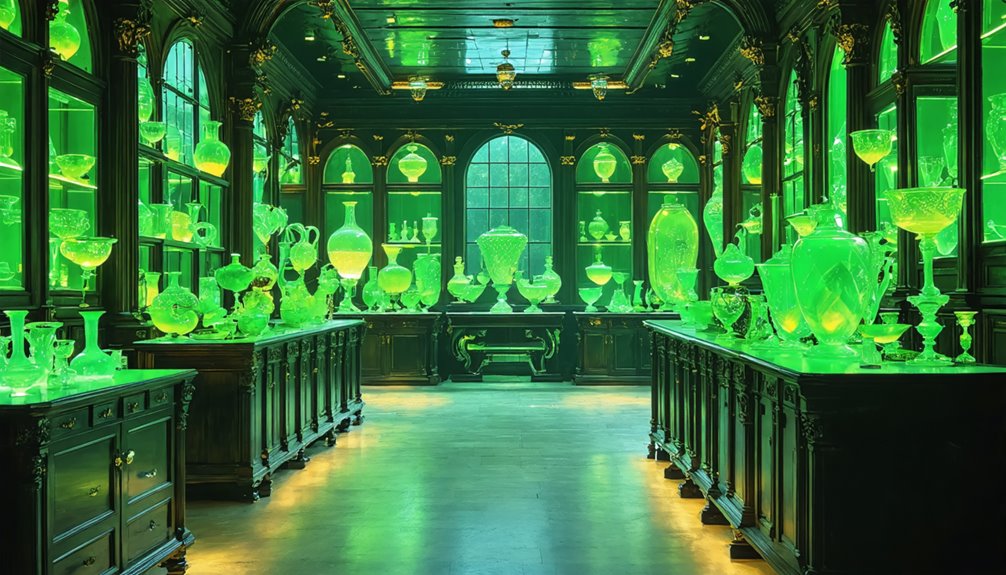
Bryce Bros. Company
Bryce Bros. Company played a key role in the history of uranium glass production. Established in Mt. Pleasant, Pennsylvania, in 1850, Bryce Bros. gained a reputation for remarkable craftsmanship and intricate Victorian novelties. Their uranium glass items, known for their bright green hue and unique glow under UV light, drew the attention of many collectors.
Some standout pieces from Bryce Bros. include the LORNE butter dish and hand-blown stemware. These items showcase the artistry involved in their creation. A notable innovation from Bryce Bros. is the underplate that was attached during the glass-making process, which added both functionality and elegance.
Bryce Bros.’ LORNE butter dish and hand-blown stemware highlight exquisite artistry, enhanced by the elegant innovation of the attached underplate.
The cultural impact of Bryce Bros. is significant. Their designs reflect the Victorian era’s love for ornate and detailed objects. Collectors today still prize these pieces for their historical value and beauty.
When I look at Bryce Bros. uranium glass, I recognize its place in the evolution of glassware design. It connects me to fellow enthusiasts who appreciate and work to preserve this fascinating legacy.
Buckeye Glass Company
When we think about 19th-century uranium glass, the Buckeye Glass Company stands out. Established in 1878 by Henry Helling in Martins Ferry, Ohio, Buckeye quickly became known for its unique patterns and high-quality glassware.
Their uranium glass was bright and colorful, capturing the attention of many collectors. This glassware featured a level of beauty and craftsmanship that was rare for its time.
Harry Northwood took over as General Manager in 1887. He brought new techniques and designs to the company, further enhancing its reputation. Under his leadership, Buckeye produced stunning pieces that showcased both skill and creativity.
If you’re interested in Buckeye’s uranium glass, here are a few notable pieces to consider:
- The unique SHELDON SWIRL lamp, which stands out for its design.
- Canary glass that shines with vibrant colors.
- Intricate patterns that highlight the artistry of the glassmakers.
Uranium glass was popular for its striking appearance and its ability to glow under UV light, making it a favorite among collectors and decorators.
Its early uses included tableware and decorative objects, allowing people to enjoy both functionality and beauty in their homes.
Burtles, Tate & Co
When discussing the history of uranium glass, Burtles, Tate & Co. stands out. Founded in 1891 in Manchester, England, this manufacturer emerged as a key player in the production of striking glassware. Their designs weren’t just practical; they were artistic and imaginative.
One of the most enchanting pieces from Burtles, Tate & Co. is the Elephant flower holder. It showcases their playful approach to design. Another notable item is the Mermaid flower trough, which displays elegance and charm. Both pieces highlight how the company used uranium glass to create vivid, glowing colors. This use of vibrant materials resonated with the Victorian era, a time when people were fascinated by new and unique substances.
While Burtles, Tate & Co. may not be as widely recognized as some other glass manufacturers of the time, their uranium glass creations have a special allure.
Today, collectors appreciate these distinct pieces for their beauty and rich history. The craftsmanship of Burtles, Tate & Co. continues to inspire and attract enthusiasts, ensuring that their work remains relevant in the world of decorative arts.
Cambridge Glass Company
When we look at early American uranium glass, Cambridge Glass Company stands out. It began around 1901 and is known for its creative designs. One notable piece is the Volstead Dog. This fun 8-ounce vaseline glass item captures attention with its unique shape and color.
Another remarkable creation is the #1 KEG set. It comes in transparent and frosted “TOPAZ” uranium glass. This set shows how Cambridge expertly used color and finishing techniques. They created a variety of vibrant shades, including the bright, glowing PISTACHIO. These colors demonstrate the skill and careful work that made Cambridge Glass Company one of the top names in uranium glass in America.
Early uses of uranium glass weren’t just for show. Many households embraced it for its striking appearance. People appreciated its glow under UV light, which added a magical touch to dining and decor.
Cambridge played a significant role in this trend, making uranium glass a popular choice in the early 20th century. Their craftsmanship and creativity helped shape a unique chapter in glassmaking history.
Iconic Vaseline Glass Pieces
Uranium glass, often called Vaseline glass, has an interesting history. It became popular in the early 20th century. The Cambridge Glass Company was a key player in this market. They produced some of the most distinctive pieces.
One standout piece is The Volstead Dog. This collectible holds about 8 ounces. It showcases the skilled craftsmanship of the Cambridge Glass Company. The design and shape make it a favorite among collectors.
Another notable item is The #1 KEG Set. This set comes in both transparent and frosted uranium glass. Its versatility in style and finish appeals to many collectors.
There’s also the PISTACHIO Color Variation. This variant has a soft green glow. It adds a unique touch to the already celebrated range of Cambridge’s Vaseline glass creations.
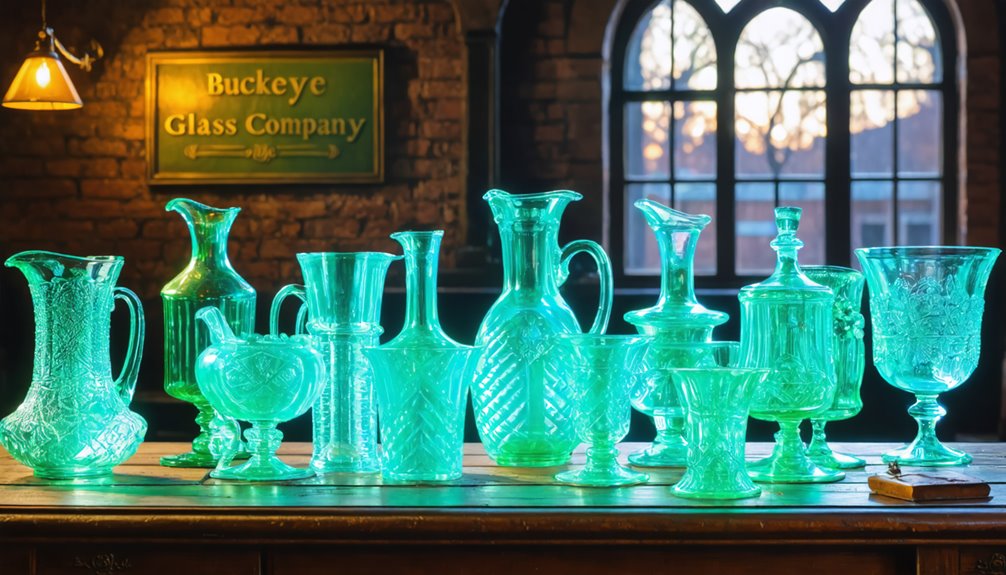
Vaseline Production and Techniques
Vaseline glass, also known as uranium glass, has a fascinating history. The Cambridge Glass Company, established in the early 1900s, played a pivotal role in its development. This company, officially recognized as Cambridge Glass Co. in 1907, became famous for its unique use of uranium oxide. This special ingredient gave the glass its striking yellow-green color and allowed it to glow brilliantly under ultraviolet light.
The artisans at Cambridge Glass were skilled in both traditional and modern glassblowing techniques. They created whimsical items like the Volstead Dog, which holds 8 ounces. Their work combined intricate designs that appeal to collectors. The glass also came in various colors, including transparent and frosted versions, but the defining feature remained its fluorescence under UV light.
Uranium glass wasn’t just beautiful; it had practical uses as well. In the early 20th century, it was popular for household items and decorative pieces. The glow and color made it a favorite among those seeking to add a touch of elegance to their homes.
Today, collectors cherish these pieces, not only for their aesthetic appeal but also for their historical significance. The Cambridge Glass Company’s innovation in using uranium oxide set a new standard in the glassmaking industry.
Challinor, Taylor & Co
Challinor, Taylor & Co. is one of the notable early American manufacturers known for uranium glass production in the late 19th and early 20th centuries. They were significant in making uranium glass popular with their unique creations.
Their pieces aren’t just beautiful; they also tell a story about the time they were made. Many collectors admire these items for their historical value and artistic craftsmanship.
One standout piece is the charming child’s mug called “BIRD IN NEST WITH FLOWERS.” This mug features an intricate design of a bird protecting its eggs, showcasing the delicate artistry of the era.
The vibrant colors of their uranium glass reflect the artistic trends of the time. The glass glows under ultraviolet light due to the uranium content, adding to its appeal.
In 1891, Challinor, Taylor & Co. joined the U.S. Glass combine. This union helped the company grow and reach a wider audience.
Their legacy continues to influence the appreciation of uranium glass today.
Geo. Davidson & Co
When I think of Victorian uranium glass, Geo. Davidson & Co. stands out. Their Pearline Primrose glassware is especially notable. These pieces shine with a unique yellow-green glow. They’re some of the most well-known items from the late 19th century’s decorative arts scene.
The designs of this glassware show the creativity and skill of the era. Many collectors today admire these pieces for their beauty and historical value. Uranium glass was first used in the early 1830s, and it caught on due to its striking appearance. The glass contained small amounts of uranium, which made it glow under UV light.
Initially, uranium was used in glass to enhance color and add brightness. Over time, it became popular not just for its looks, but also for its novelty. People were fascinated by the glowing effect, and it became a conversation starter in homes.
Geo. Davidson & Co. perfectly captured this trend with their Pearline Primrose glassware. Their work reflects the innovative spirit of the time, making it a cherished part of glass-making history.
Pearline Primrose Glassware
If you find antique uranium glass fascinating, consider the Pearline Primrose pattern by Geo. Davidson & Co. This collection stands out for its unique opalescent vaseline finish. You’ll notice a beautiful blend of yellow and green, adorned with a delicate floral design. Made from 1867 until around World War II, Pearline Primrose showcases the artistry and innovation of its time.
Geo. Davidson & Co. played a key role in the history of uranium glass, and these pieces reflect the craftsmanship and elegance of the Victorian era.
To truly enjoy Pearline Primrose glassware, keep these points in mind:
- Observe how the colors shift in different lights.
- Appreciate the detailed textures in each floral design.
- Recognize its important role in the early production of uranium glass.
Uranium glass was first popularized in the 1830s. Initially, it was used in everyday items, showcasing its glowing properties. Many people embraced its unique look, and it became a favorite among collectors.
During the Victorian era, manufacturers experimented with uranium to create stunning glassware. Pearline Primrose is a perfect example of this innovation.
In addition to its beauty, uranium glass has an interesting scientific background. The uranium content gives it a slight glow under ultraviolet light, making it a captivating addition to any collection.
Each piece tells a story of its time, blending art with history. Collectors appreciate not just the visual appeal but also the cultural significance behind these items.
Distinctive Victorian Designs
Uranium glass, also known as Vaseline glass, has a fascinating history. Many Victorian manufacturers created this unique glass, but Geo. Davidson & Co truly stands out. Founded in 1867, they made decorative glassware that reflected the ornate style of the Victorian era. Each piece was crafted with care, showcasing detailed patterns that were popular at the time.
Geo. Davidson & Co used uranium oxide in their glass production. This gave their creations a striking yellow-green color and a captivating opalescent effect called Pearline Primrose. Collectors and homeowners admired their craftsmanship and artistic style.
Even today, the appeal of their uranium glass endures, linking us to a rich history of beauty and elegance. While production has decreased over the years, the legacy of Geo. Davidson & Co lives on. Their pieces remain highly sought after by collectors.
The allure of uranium glass connects us to the creativity and innovation of the past, reminding us of the artistry that defined the Victorian era.
Frequently Asked Questions
What Companies Made Uranium Glass?
Uranium glass has a fascinating history. Early glassmakers, such as Fenton, Tiffin, and Imperial, played a significant role in its creation. They infused glass with uranium to create vivid colors and unique patterns. This type of glass became popular in the late 19th and early 20th centuries.
Collectors are drawn to uranium glass for its striking appearance and historical significance. Many pieces glow under ultraviolet light due to the uranium content. This glow adds to their allure, making them fun to display and collect.
Enthusiasts often share their finds and knowledge about the glass. Connecting with others who appreciate the beauty of uranium glass creates a sense of community. The history of this glass is not just about its creation but also about the stories behind each piece.
How to Tell if Uranium Glass Is Vintage?
Uranium glass has a fascinating history. It was first made in the early 19th century. At that time, glassmakers discovered that adding uranium to glass created a striking green or yellow color. This unique trait made it popular for decorative items.
In the late 1800s and early 1900s, uranium glass became even more trendy. Companies like Fenton and Westmoreland produced beautiful pieces, often used for tableware. Many people admired its unusual glow under ultraviolet light. This glow comes from the radioactive properties of uranium, which makes the glass stand out.
Collectors today enjoy finding vintage uranium glass. To determine if a piece is genuine, the glow test is quite effective. Shining an ultraviolet light on the glass reveals its luminescence. Authentic uranium glass will emit a bright greenish glow. This simple test helps collectors identify true vintage pieces from modern imitations.
Who Produced Uranium Glass?
Uranium glass has a rich history that dates back to the early 19th century. Various manufacturers experimented with uranium compounds to create vibrant, glowing glassware. These artisans developed unique techniques to incorporate uranium into their glass, producing distinctive pieces that fascinated collectors and everyday users alike.
In the early years, uranium glass served practical purposes. It was often used for tableware, decorative items, and even some scientific instruments. Its bright green color and ability to fluoresce under ultraviolet light made it popular among consumers. Many households enjoyed using this striking glassware during meals and gatherings.
Several well-known companies, like Fenton Art Glass and Anchor Hocking, contributed significantly to the popularity of uranium glass. They crafted innovative designs that appealed to a broad audience. Collectors today cherish these pieces for their beauty and historical significance.
As time went on, the use of uranium in glassware became less common due to safety concerns. However, the legacy of uranium glass endures in the vibrant collector’s market, where enthusiasts seek out these captivating artifacts from the past.
What Is the Oldest Uranium Glass?
Uranium glass may seem like a recent discovery, but its history stretches back to the early 1800s. The first pieces were created in Europe, where artisans experimented with uranium to enhance the glass’s color and brilliance. This innovative use of uranium led to vibrant green and yellow glassware, which captivated collectors and enthusiasts alike.
In those days, uranium glass was not just a novelty; it had practical applications. It was often used for tableware and decorative items. The unique glow under ultraviolet light made it a popular choice for households and collectors. People were drawn to its striking appearance, and it quickly became a fashionable item.
Today, these early uranium glass pieces are highly sought after by collectors. Their rarity and historical significance contribute to their value. The craftsmanship and creativity involved in their production showcase the ingenuity of glassmakers from the past. As a result, uranium glass has earned its place as a treasured antique, glowing brightly in the hearts of those who appreciate its rich history.
Conclusion
Uranium glass has a fascinating history. Early manufacturers like Adams & Co and Geo. Davidson & Co played a pivotal role in its development. They experimented with uranium, which gave glass a unique glow under ultraviolet light. This creativity led to the creation of beautiful and striking pieces that captured the attention of collectors.
These early glassmakers were not just craftsmen; they were innovators. Their work transformed ordinary glass into radiant items that stood out in homes and displays. The vibrant colors and luminescence of uranium glass made it a popular choice during the late 19th and early 20th centuries.
People used uranium glass for various purposes, including tableware and decorative art. Its distinctive appearance made it a conversation starter. As time went on, the allure of uranium glass only grew. Collectors sought after these glowing pieces, appreciating their beauty and the skill involved in their production.
Today, the legacy of these early manufacturers remains strong. Their adventurous spirit in glassmaking still inspires artists and collectors alike. Uranium glass serves as a reminder of how innovation can create lasting impact in the world of art and craftsmanship.
